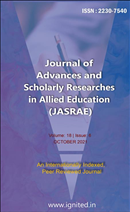Representation of Violence in Bhisham Sahni’s Tamas
Uncovering the Violence and Communal Discord in Bhisham Sahni’s Tamas
Keywords:
representation, violence, Bhisham Sahni, Tamas, religion, independence, migration, communalism, civilization, partitionAbstract
On 15th August 1947, a day when a strong nation was divided on religion and boundaries were drawn overnight. Religion which has a motto to unite the people became the cause of separation of the two countries. How strange was our independence too, the one that came with the division of our country, the largest and possibly the most frequent migration in human history, which took the worst blood bath in memory of the subcontinent? This was done extensively by Hindu, Muslim and Sikh communalists. At this juncture our nationalism had become a nationalism of mourning a kind of legitimacy, what we saw was not just British policy of divide and rule, which was certainly there, but a conspiracy to break the unity of our own civilization. We had a desire to kill that civil ethos and break a moral bond with one another, without which human community was impossible.The word 'Partition' brings frightening pictures of a nation to our mind and it tells the story of deteriorating relationships, communal discord, and disorder, feelings of loss as well as being personal, professional and emotional. A tragedy like partition cannot be changed in the field of data alone. Inclusion of the effects of genocide, riots, looting, arson, bloodshed and rape had become a feature of partition. Let us not forget that partition was not a natural disaster but a deliberate conspiracy. Freeing ourselves from colonial rule but imprisoning ourselves within the borders of nations and enslaving ourselves to communal hatred is the irony of situation. Partition shook the conscience of civilized people, destroyed human attitudes and turned people into wild animals who committed extreme barbaric cruelty against their partners, friend and decades-long relations. This division was not of nations, but of communities, values, memories and dreams. This is a phase in Indian history when Hindus won, Muslims won, colonial rulers won, freedom fighters won, political deadlock won, but humanity lost.Published
2021-10-01
How to Cite
[1]
“Representation of Violence in Bhisham Sahni’s Tamas: Uncovering the Violence and Communal Discord in Bhisham Sahni’s Tamas”, JASRAE, vol. 18, no. 6, pp. 111–114, Oct. 2021, Accessed: Jul. 02, 2024. [Online]. Available: https://ignited.in/jasrae/article/view/13522
Issue
Section
Articles
How to Cite
[1]
“Representation of Violence in Bhisham Sahni’s Tamas: Uncovering the Violence and Communal Discord in Bhisham Sahni’s Tamas”, JASRAE, vol. 18, no. 6, pp. 111–114, Oct. 2021, Accessed: Jul. 02, 2024. [Online]. Available: https://ignited.in/jasrae/article/view/13522








